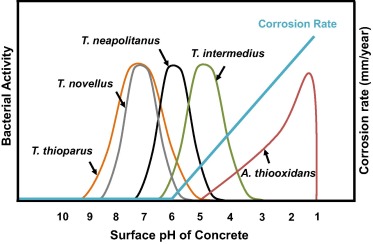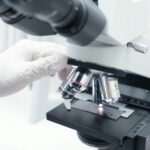Conventionally, organic matters in concrete were considered to be undesirable. But recent study with selected microbes has shed new light on its usefulness. Both useful and deteriorating microbes has been identified.
Metabolic activity of microbes produces acid which degrade concrete. These kinds of deterioration are pronounced in location having high microbial activities such as near stagnant water body, sewage treatment facility or animal barn. The pH could vary according to types of bacteria; some pH variation is shown in figure below[1]. It is practice to use antimicrobial agents (calcium formate, zeolites, ammonia, copper slag, etc) or coating in such concrete.

On contrary, new study using selected microbes has been proven good for durability of concrete structure.
In a study by Jonker, micro cracks (less than 1 micrometer) were found to heal when the sulphate resistant spore-forming bacteria [2]. The downside of this method is, the concrete should be mixed with activating agent (organic compound such as calcium lactate) which could seriously undermine other properties of concrete such as setting time. The bacteria convert calcium lactate into calcium carbonate. In another study, ureolytic bacteria was used on the surface of concrete, which also helped to form a layer of calcium carbonate in the surface and reduce permeability of concrete.
Strength gain of 25% was reported by using thermophilic anaerobic microorganism by adding 10e5 cell/ml[3].
Can microbial reduce corrosion?
There is an idea to protect reinforcing steel by adding bacteria to concrete, which consumes oxygen content and thus preventing oxidation of steel[4]. The short term experiments showed that there is reduction in corrosion potential in cracked concrete by adding Bacillus subtilis natto.
Table below gives some list of good and bad microbes for health of concrete.
| Useful microbes | Harmful microbes |
|
|
Reference
- [1] Noeiaghaei, T., Mukherjee, A., Dhami, N., & Chae, S. R. (2017). Biogenic deterioration of concrete and its mitigation technologies. Construction and Building Materials, 149, 575-586.
- [2] Jonkers, H. M., Thijssen, A., Muyzer, G., Copuroglu, O., & Schlangen, E. (2010). Application of bacteria as self-healing agent for the development of sustainable concrete. Ecological engineering, 36(2), 230-235.
- [3]
- [4] Kawaai, K., Nishida, T., Saito, A., Ujike, I., & Fujioka, S. (2019). Corrosion resistance of steel bars in mortar mixtures mixed with organic matter, microbial or other. Cement and Concrete Research, 124, 105822.








